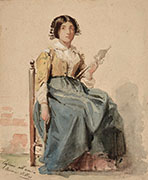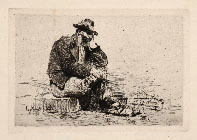(Casale Monferrato 1826 - Milan 1903)
A LION
Etching, a rare print, unsigned, which has never had an edition, unlike many other prints by Pagliano published in art magazines as L'Arte in Italia. Catalogued by Amalia Mezzetti, in 1935, as a work by Gioacchino Banfi, the etching has been recognized as Pagliano's work by Alfredo Petrucci, who reproduced an impression, signed in pen, in his book devoted to the Italian etchers of 19th century. See Alfredo Petrucci, l'incisione italiana, l'Ottocento, Rome, 1941. Petrucci considered this among the best etchings by Pagliano. In fact the print shows the characters of an experimental etching, much different from the majority of the known prints by the artist, often reproductive after his own paintings and showing a skillful but rather controlled technique. Here, to depict, part of the shadows around the wild animal, the artist used the open bite etching, that is the direct brushing of the plate with neat acid, a useful way for creating tonal variations, but difficult to control if used over large areas.
The impression, richly inked, has been printed on an old sheet of eighteenth century laid paper, another element which indicates the print as an artist's proof. With margins, minor defects, generally in very good condition. To the platemark 230 x 300 mm, the entire sheet measuring 310 x 415 mm.
My warmest thanks to Antonio Bariletti for his help in cataloguing this print.
A painter, etcher and an active contributor to the Italian Risorgimento, Eleuterio Pagliano studied at the Milanese Academy of Brera, to which he enrolled in 1836, at eleven years, on Sabatelli's recommendation. A patriot, in 1848 Pagliano joined the popular revolt against the Austrian garrison in Milan known as Le Cinque Giornate and in 1849 he fought under Garibaldi in Rome. In the early fifties he met and became friends with Domenico Morelli, whose anti-academic researches influenced Pagliano's painting, thematically oriented toward the historical and patriotic subjects. After 1851 he also painted many portraits, reinterpreting the traditional style of romantic portraiture. In 1859 Pagliano volunteered to fight with Garibaldi in the Second War of Independence, as a lieutenant in the Cacciatori dell Alpi, and after this experience in his paintings depicting military episodes he tried to convey with immediacy their rawness. In his later depictions of Risorgimento episodes Pagliano also succeed in avoiding excessive rhetoric, as in the body of Luciano Manara visited by soldiers, executed for the Esposizione Nazionale in Turin in 1884. Pagliano treated skillfully, as a painter, other nineteenth-century themes and was also an excellent etcher and watercolourist. He participated in important exhibitions throughout Europe and won prestigious awards.





